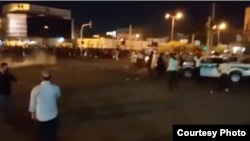Water shortage protests in drought-plagued southwestern Iran appear to have spread to more cities and resulted in what authorities say is a third fatality as the unrest extended into a seventh day.
Videos posted to social media appeared to show street protests on Wednesday in several parts of Khuzestan province, including the capital, Ahvaz, and the cities of Behbahan, Dezful, Izeh, Masjed Soleyman, Ramshir and Susangerd.
In one clip said to be from Izeh, security forces appeared to fire tear gas at protesters. In another clip said to be from Masjed Soleyman, demonstrators chanted, "Police, support us," a reference to local concerns about security forces cracking down harshly on earlier rallies.
Other social media videos appeared to show Iranians in the city of Yazdenshahr, in neighboring Isfahan province, rallying in support of the Khuzestan protesters. The Isfahan rally would be the first such protest in the province since the daily protests began in Khuzestan last Thursday and evolved into the widest and most sustained disturbances Iran has seen in months.
VOA could not independently verify the videos said to be from Khuzestan and Isfahan. Iran has barred VOA from reporting inside the country.
In another development, Iranian state-approved news site ILNA quoted the top official of Izeh city in Khuzestan, Hassan Nabouti, as reporting the death of one person in local protests against water shortages on Tuesday.
Nabouti said the person was wounded in the protests, taken to a hospital by a private car and was pronounced dead. Nabouti said an investigation was under way to identify the attacker and added that 14 security personnel were hurt in the protests.
Another Iranian state news agency, Fars, identified the fatality as a young man named Hadi Bahmani.
Social media users posted video on Thursday purporting to show Bahmani's burial on the outskirts of Izeh. They said he was a 17-year-old construction worker.
Iranian state media previously reported the killings of two men by gunfire during demonstrations last Friday.
Social media videos that appeared to be from Tuesday's protests in Izeh but that could not be verified by VOA showed protesters chanting "Death to Khamenei" and "Reza Shah, bless your soul." Gunshots were also heard in those videos.
"Death to Khamenei" has been a common refrain of Iranian anti-government protesters angered by the authoritarian rule of Supreme Leader Ayatollah Ali Khamenei in recent years.
"Reza Shah, bless your soul" also has been uttered in previous waves of Iranian street protests as a sign of affection toward the founder of the nation's former monarchy, Reza Shah. Khamenei's predecessor, Ayatollah Ruhollah Khomeini, ousted Reza Shah's son from power in Iran's 1979 Islamic Revolution.
Digital communication with the Iranian protest regions remained difficult. London-based internet monitoring group NetBlocks said there had been a "significant regional disruption to mobile internet service in Iran" since the water shortage protests began one week ago.
"Cellular data analysis metrics corroborate widespread user reports of cellular network disruptions, consistent with a regional internet shutdown intended to control protests," Netblocks said in an online statement.
Iranian state-approved news agency ISNA said President Hassan Rouhani told Khuzestan's provincial governor in a Thursday phone call that authorities must listen to and respect the rights of protesters who have suffered from drought and extreme heat. ISNA said Rouhani also had ordered First Vice President Eshaq Jahangiri to visit Khuzestan on Friday to investigate the situation there.
In a Wednesday press briefing, U.S. State Department spokesman Ned Price said Washington was closely following the Khuzestan protests, "including reports that security forces have fired on protesters."
"We support the rights of Iranians to peacefully assemble and to express themselves. Iranians, just like any other people, should enjoy those rights without fear of violence, without fear of arbitrary detention by security forces," Price said.
Iran's water shortages are partly the result of weather-related factors, including a sharp drop in rainfall, which has been more than 40% below last year's levels in recent months, and high summer temperatures.
Experts say decades of Iranian government mismanagement also have fueled the drought. They blame authorities' poorly considered placement and construction of hydroelectric dams and the diversion of water from Khuzestan's rivers and wetlands to industrial sites in neighboring regions, practices that have dried up sources of drinking and agricultural water for the province's residents.
This article originated in VOA's Persian Service . Click here and here to read the original Persian versions of this story.








